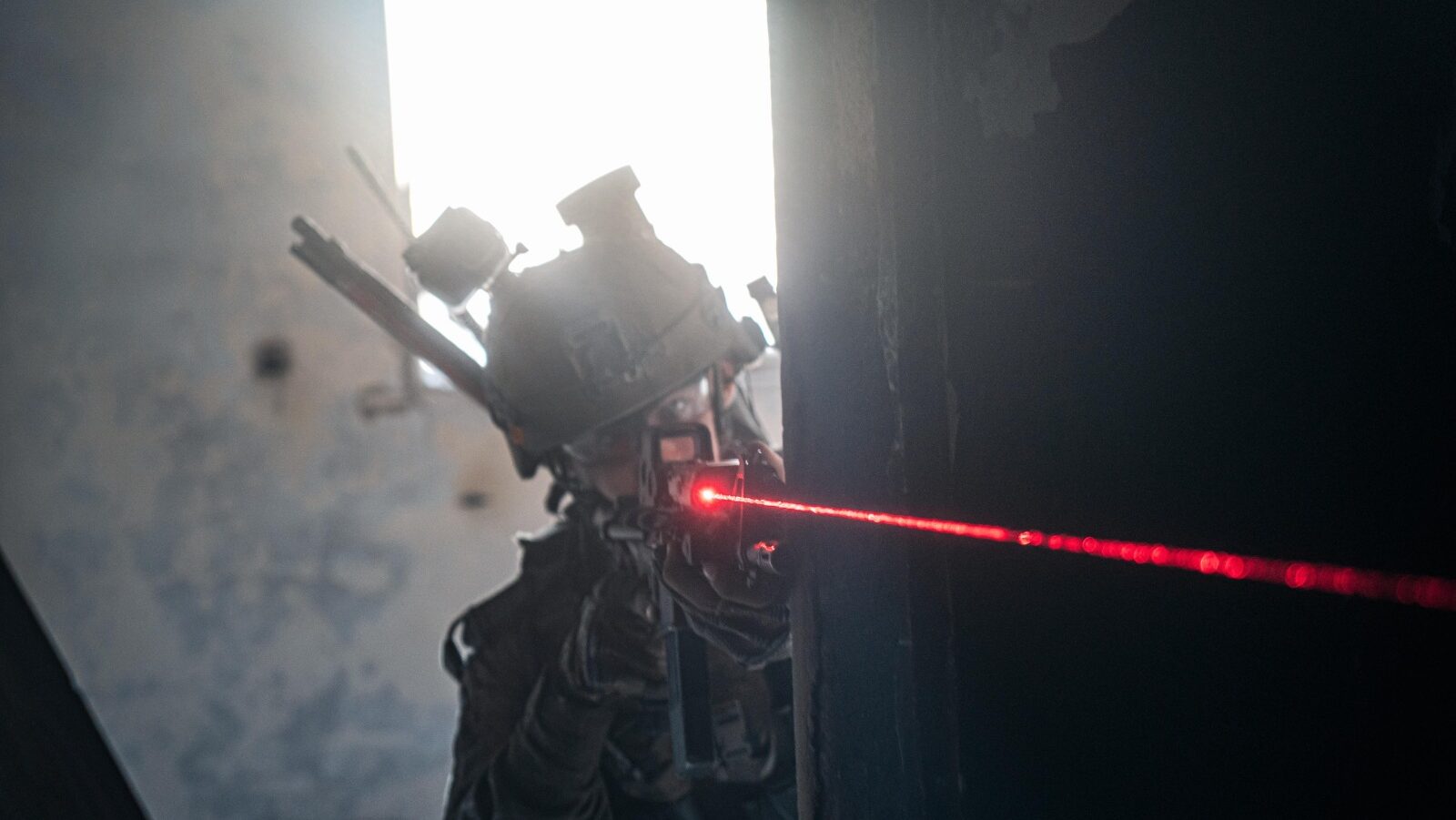
A soldier in the IDF’s Multidimensional Unit aims around a corner. (IDF)
JERUSALEM — As the conflict in Gaza stretches beyond 100 days, members of the Israel Defense Forces’s Multidimensional Unit say their combat operations have been a proving ground for the novel use of new technologies on a tactical level — with some revelations that could spread to the rest of the IDF.
“We have executed what we have been training on, and I can tell you it works,” one member, identified only as Maj. R. for security reasons, told Breaking Defense during a phone interview. “The whole concept of multidimensional battlefield is working at a tactical level. We in Israel were the first to execute something like that at a tactical level at the unit level.”
On Jan. 13 the IDF announced that “for the first time since its establishment, the Multidimensional Unit was activated in a ground operation. The unit, established four years ago, integrates innovative technologies with special capabilities alongside teams of soldiers operating in parallel.”
The IDF said that the unit is using “advanced drones and a combination of technological capabilities for target identification and direction of fire.” This has led to the destruction of anti-tank missile positions, the elimination of terrorists and location of weapons in civilian areas, according to the IDF.
The Multidimensional unit goes by several names in Israel, it is also called the “Ghost” unit and Unit 888. Structurally it is part of the new 99th Division which is a “multi-arena infantry division” that is supposed to bring together ground forces with the air force and other assets. The Multidimensional Unit doesn’t necessarily only operate with the 99th though, it has operated with other units in Gaza, according to discussions with the IDF. A previous statement from the IDF on Dec. 24 noted that the unit has been active in northern Gaza, in the area of Jabalya, where the IDF’s 162nd Division has been active.
The Multidimensional Unit draws its soldiers from commando and elite reconnaissance units. It has then been provided a plethora of new technology to use, such as small drones and the Iron Sting precision mortars.
The idea of combining artillery and airborne assets into one unit is not a new concept of warfare, but Maj. R. told Breaking Defense that pushing that combination down to the tactical small unit level is unique. What that means is not relying on the battalion, brigade or division level for these kinds of capabilities. The officer said that their operations in Gaza have illustrated that soldiers can have multiple disciplines or professions within a small unit and work with a high “cognitive load.”
The major said that when the unit uses new technology, such as the Iron Sting mortars, or the small drones it uses for surveillance and strikes, it categorizes them according to how they might be integrated on the battlefield. This could mean some technologies are a good proof of concept but require more work, some technologies work but would require more training for soldiers to easily use the capability, and others are user friendly and can be pushed out to other units.
“We get it [new technology] first, and we make sure it is viable in the field,” said Sgt. Maj. A., whose name was also withheld for security reasons. He said many of the systems the unit has used in Gaza have been effective, although the IDF doesn’t specify the names for these new systems.
Israel has come under withering international condemnation for the toll its military campaign against Hamas in Gaza has taken in thousands of civilian lives — including allegations of “genocide” by South Africa at the United Nations and increasingly public frustration from US President Joe Biden. But on a tactical level, the Multidimensional Unit members said that the tech they’ve employed helps them act with greater precision to reduce both their own casualties and those of civilians.
Sgt. Maj. A., for example, contrasted methods of previous wars where soldiers would have to knock down doors to hunt down terrorists in an urban area, to tactics where small drones and other surveillance technology can identify enemies and make sure there aren’t civilians among them, before the military carries out a precision strike.
This is relevant for how the IDF has conducted operations in Gaza. In the wake of the Hamas attack on Israel on Oct. 7, the IDF carried out a multi-week air campaign in retaliation before moving ground forces into Gaza on Oct. 27. The initial ground offensive focused on northern Gaza. Israel has operated to try to eliminate threats through calling in airstrikes, and using various types of drones, loitering munitions and artillery to reduce major firefights with Hamas. Hamas battalions were also degraded in these operations; the IDF estimates 9,000 terrorists have been eliminated, which means there are less Hamas units left intact to conduct large unit engagements with the IDF. (The Hamas-run Health Ministry in Gaza said more than 24,000 people had been killed in the conflict.)
For Israeli troops on the ground, this kind of asymmetric war, with less contact between two large forces along a frontline, meshes well with the kind of technology the Multidimensional Unit has been using. For instance, based on the discussions with the unit’s members, this could mean operating a number of small drones in an urban environment, waiting patiently for a threat to emerge and confirming it is an enemy combatant before using a precision mortar.
The war in Gaza is far from over. Israel has begun to redeploy several reserve brigades out of Gaza and has redeployed the 36th division, a large armored division that had been responsible for major operations in neighborhoods south of Gaza City.
The next phase of operations for the Multidimensional Unit and the 99th Division remains to be seen.








